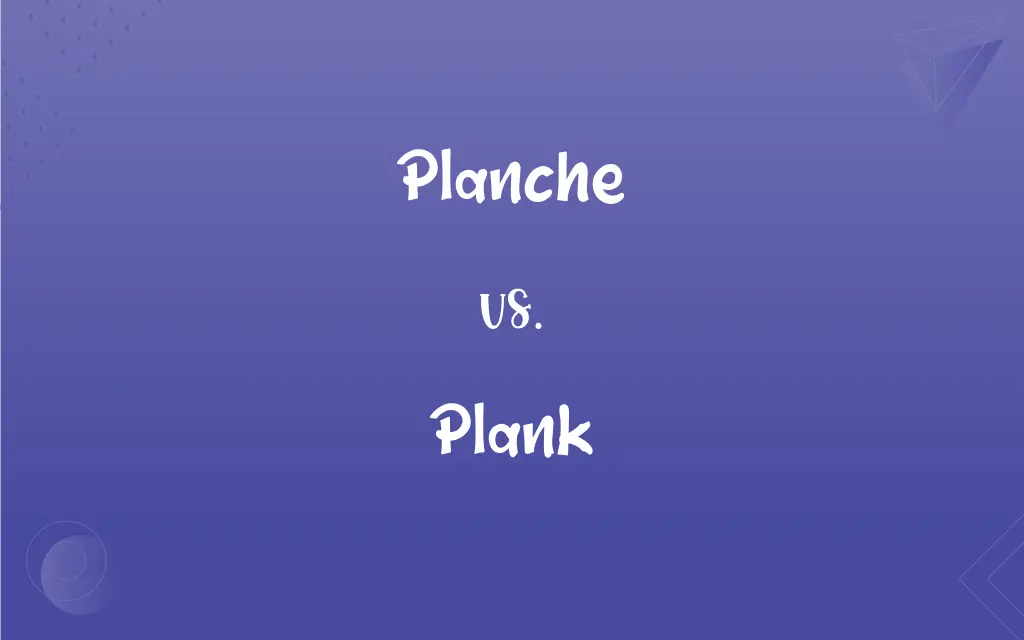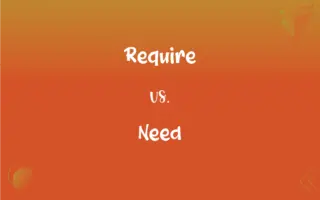Planche vs. Plank: What's the Difference?
By Janet White & Harlon Moss || Updated on May 22, 2024
A planche is an advanced gymnastics move involving holding the body parallel to the ground using only the hands, while a plank is an isometric core exercise where the body is held in a straight line supported by the arms and toes.

Key Differences
A planche is an advanced gymnastic skill where the body is held parallel to the ground, supported only by the hands. It requires significant upper body and core strength, as well as balance. A plank, on the other hand, is a fundamental core exercise that involves maintaining a straight line from head to heels while supported on the forearms and toes (forearm plank) or on the hands and toes (high plank).
GPT
Brief Comparison
A planche is an advanced gymnastics move involving holding the body parallel to the ground using only the hands, while a plank is an isometric core exercise where the body is held in a straight line supported by the arms and toes.
Concise Explanation
ADVERTISEMENT
A planche is an advanced gymnastic skill where the body is held parallel to the ground, supported only by the hands. It requires significant upper body and core strength, as well as balance. The planche is often seen in gymnastics and calisthenics, highlighting an athlete's strength and control.
A plank, on the other hand, is a fundamental core exercise that involves maintaining a straight line from head to heels while supported on the forearms and toes (forearm plank) or on the hands and toes (high plank). The plank targets the core muscles, including the abdominals, lower back, and shoulders, and is commonly used in various fitness routines for its effectiveness and simplicity.
The planche demands advanced skill, strength, and training, often taking months or years to master. In contrast, the plank is accessible to beginners and can be modified to suit different fitness levels, making it a staple in many exercise programs.
While the planche is performed with the body parallel to the ground and requires full body control and strength, the plank is performed with the body in a straight line and focuses on building core stability and endurance.
Comparison Chart
Definition
Advanced gymnastic move, body parallel to ground
Core exercise, body in a straight line
ADVERTISEMENT
Skill Level
Advanced
Beginner to advanced
Body Position
Parallel to the ground
Straight line from head to heels
Support Points
Hands
Forearms and toes (forearm plank) or hands and toes (high plank)
Focus
Upper body strength, balance, and control
Core stability and endurance
Training Requirements
Extensive training and practice
Suitable for all fitness levels
Planche and Plank Definitions
Planche
Requires core strength and balance.
Achieving a planche demands intense core and upper body workouts.
Plank
Core exercise holding a straight line from head to heels.
She holds a plank for two minutes every morning.
Planche
Exercise requiring significant upper body strength.
Mastering the planche takes months of dedicated strength training.
Plank
Performed on forearms and toes or hands and toes.
The fitness instructor demonstrated a perfect high plank.
Planche
Advanced gymnastic move with body parallel to the ground.
The gymnast performed a perfect planche during his routine.
Plank
Targets core, shoulders, and lower back.
Planks are great for strengthening the entire core.
Planche
Balancing on hands with the body horizontal.
Her ability to hold a planche impressed everyone at the gym.
Plank
A piece of lumber cut thicker than a board.
Planche
Seen in gymnastics and calisthenics.
The planche is a common element in advanced calisthenics routines.
Plank
Such pieces of lumber considered as a group; planking.
Planche
(gymnastics) A position where the gymnast is horizontal and face-down, using only the hands as support.
Plank
A foundation; a support.
Plank
One of the articles of a political platform.
Plank
To furnish or cover with planks
Plank a muddy pathway.
Plank
To bake or broil and serve (fish or meat) on a plank
"Boards specially made for planking food have grooves ... to hold juices" (Michael Stern).
Plank
To put or set down emphatically or with force.
Plank
A long, broad and thick piece of timber, as opposed to a board which is less thick.
Plank
(figurative) A political issue that is of concern to a faction or a party of the people and the political position that is taken on that issue.
Germanization was a central plank of German conservative thinking in the 19th and 20th centuries.
Plank
Physical exercise in which one holds a pushup position for a measured length of time.
Plank
A stupid person, idiot.
Plank
That which supports or upholds.
Plank
(transitive) To cover something with planking.
To plank a floor or a ship
Plank
(transitive) To bake (fish, etc.) on a piece of cedar lumber.
Plank
To lay down, as on a plank or table; to stake or pay cash.
To plank money in a wager
Plank
(transitive) To harden, as hat bodies, by felting.
Plank
To splice together the ends of slivers of wool, for subsequent drawing.
Plank
(intransitive) To pose for a photograph while lying rigid, face down, arms at side, in an unusual place.
Plank
A broad piece of sawed timber, differing from a board only in being thicker. See Board.
Plank
Fig.: That which supports or upholds, as a board does a swimmer.
His charity is a better plank than the faith of an intolerant and bitter-minded bigot.
Plank
One of the separate articles in a declaration of the principles of a party or cause; as, a plank in the national platform.
Plank
To cover or lay with planks; as, to plank a floor or a ship.
Plank
To lay down, as on a plank or table; to stake or pay cash; as, to plank money in a wager.
Plank
To harden, as hat bodies, by felting.
Plank
To splice together the ends of slivers of wool, for subsequent drawing.
Plank
A stout length of sawn timber; made in a wide variety of sizes and used for many purposes
Plank
An endorsed policy in the platform of a political party
Plank
Cover with planks;
The streets were planked
Plank
Set (something or oneself) down with or as if with a noise;
He planked the money on the table
He planked himself into the sofa
Plank
Cook and serve on a plank;
Planked vegetable
Planked shad
Plank
Suitable for all fitness levels.
Beginners start with a 30-second plank and gradually increase time.
Plank
Common in various exercise routines.
Planks are a staple in yoga, Pilates, and fitness workouts.
FAQs
How long does it take to master a planche?
Mastering a planche can take months or even years of dedicated training.
What is a planche?
A planche is an advanced gymnastic move where the body is held parallel to the ground, supported only by the hands.
How is a plank performed?
A plank is performed by holding the body in a straight line from head to heels, supported on the forearms and toes or hands and toes.
Are there different types of planks?
Yes, there are various plank variations, including forearm plank, high plank, and side plank.
Can planks help with posture?
Yes, planks can help improve posture by strengthening core and back muscles.
How do you progress to a planche?
Progression to a planche involves building strength through exercises like push-ups, planks, and gradually attempting more advanced holds.
What muscles does a plank target?
A plank targets the core muscles, including the abdominals, lower back, and shoulders.
Can planks be modified for different fitness levels?
Yes, planks can be modified to suit beginners to advanced practitioners.
How often should you practice planks?
Planks can be practiced daily or several times a week as part of a fitness routine.
Is a planche suitable for beginners?
No, a planche is an advanced skill requiring significant strength and training.
What are the benefits of doing planks?
Planks improve core stability, endurance, and overall body strength.
Why is the planche considered advanced?
The planche is considered advanced due to the high level of strength, balance, and control required.
What is the main focus of a planche?
The main focus of a planche is on upper body strength, balance, and core control.
Can planks be included in a weight loss program?
Yes, planks are effective for core strengthening and can be part of a weight loss program.
How can you increase the difficulty of a plank?
Increasing plank difficulty can be done by adding movement, such as lifting one leg or arm, or by holding the plank for a longer duration.
Do planks require any special equipment?
No, planks do not require any special equipment and can be done anywhere.
What are some common mistakes in doing planks?
Common mistakes include sagging hips, lifting the hips too high, and not keeping the body in a straight line.
What is the most challenging part of a planche?
The most challenging part of a planche is maintaining balance while holding the body parallel to the ground.
What is the primary benefit of a planche?
The primary benefit of a planche is the development of extraordinary upper body strength and balance.
Are planches used in any specific sports?
Planche moves are commonly used in gymnastics and calisthenics.
About Author
Written by
Janet WhiteJanet White has been an esteemed writer and blogger for Difference Wiki. Holding a Master's degree in Science and Medical Journalism from the prestigious Boston University, she has consistently demonstrated her expertise and passion for her field. When she's not immersed in her work, Janet relishes her time exercising, delving into a good book, and cherishing moments with friends and family.
Co-written by
Harlon MossHarlon is a seasoned quality moderator and accomplished content writer for Difference Wiki. An alumnus of the prestigious University of California, he earned his degree in Computer Science. Leveraging his academic background, Harlon brings a meticulous and informed perspective to his work, ensuring content accuracy and excellence.































































